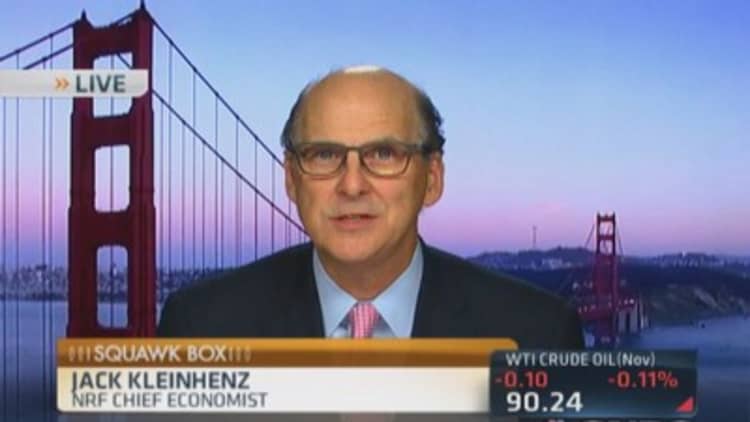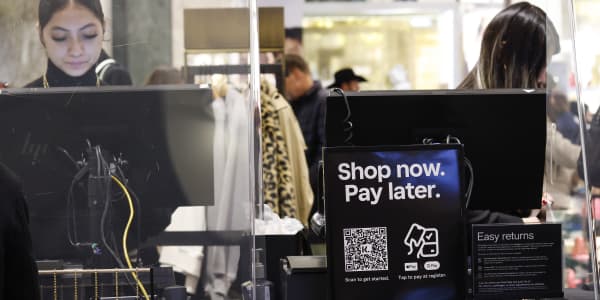As retail experts begin to unwrap their holiday forecasts, the shaky economic recovery is delivering some mixed signals.
The National Retail Federation on Tuesday said it expects holiday sales to increase 4.1 percent to $616.9 billion in 2014, up one percentage point from last year in what would be the first gain of more than 4 percent in three years.
But a separate report issued by PwC Tuesday found that projected average household spending is expected to decline to $684 this year, down from $735 in 2013.
Read MoreNo coal here: Holiday forecast calls for 4% growth
Leading the anticipated drive lower is a growing group of consumers the firm labeled "survivalists"—people who earn less than $50,000 annually and represent 67 percent of American shoppers. That's up from 65 percent in 2013, and 63 percent in 2012.

Still, what the two firms can agree on are that despite NRF's rosier outlook, which is hinged on improving economic fundamentals such as jobs and housing data, consumers will remain cautious when opening their wallets.
"While expectations for sales growth are upbeat, it goes without saying there still remains some uneasiness and anxiety among consumers when it comes to their purchase decisions," NRF President and CEO Matthew Shay said. "Recognizing the need to keep household budgets in line, we expect shoppers will be extremely price sensitive as they have been for quite some time."
Read MoreRadioShack hoping for a Christmas miracle
NRF's holiday forecast is based on a model that uses indicators such as consumer credit and disposable personal income to predict sales in November and December excluding autos, gas and restaurants. Last year, sales fell short of the trade organization's forecast for 3.9 percent growth.
PwC's report is based on a poll of more than 2,200 consumers across the U.S. that spanned all demographics and income levels, and defines the holiday season as September through January.
The groups' estimates follow a forecast from Deloitte last month, which predicted holiday sales will increase between 4 percent and 4.5 percent from November through January.
Bring on the discounts
PwC's study underscored shoppers' price sensitivity, with 84 percent of respondents saying they plan to spend the same or less than they did in 2013. When broken down by income, "survivalists" plan to spend on average $377 per household, a dramatic drop compared with last year's $435. "Selectionists," who earn more than $50,000 annually, will spend an average $978 per household—down from $986 in 2013.
Regardless of their income level, PwC said shoppers will spend with an "every dollar counts" mindset, with 84 percent of shoppers listing price as the main driver behind where they will purchase a gift. That's up from 74 percent in 2013.
This point, paired with consumers' expectation that retailers will offer deep discounts, will result a "deluge" of promotions—despite shoppers' plan to make more purchases ahead of and during the week of Black Friday, said Thom Blischok, chief retail strategist at PwC's Strategy& division. As such, retailers are keeping inventories lean and planning their price cutting strategy ahead of time, in an effort to preserve their margins.
"They're planning for a pretty conservative holiday," Blischok said.
Another digitally driven holiday
Online sales are expected to see another year of fast-paced growth. NRF's digital division, Shop.org, predicts online sales will grow between 8 and 11 percent compared with last year, to as much as $105 billion. That's on top of last year's 8.6 percent growth for sales outside traditional retail stores, the group said.
"A new Thanksgiving ritual of shoppers going online to prepare their 'holiday shopping plan' has emerged and may be the most significant shopping pattern change this season," PwC said in its report.
Another difference from 2013? Bricks-and-mortar retailers are starting to catch up on their digital capabilities. Whereas "buy online and pick up in store" was just getting started last year, traditional retailers this year will reap the benefits of experience and scale from these programs, Blischok said. Macy's, for example, recently rolled out this capability to all of its stores.
Read MoreHoliday hiring may hit dot-com boom level
After 2013's holiday shipping mishaps, when high demand and a series of snowstorms prevented many Christmas packages from being delivered on time, PwC also predicts retailers will be better prepared to manage elevated volumes, and use the web offensively during bad-weather periods. This could include targeted online-only promotions when a significant amount of snow is dumped on a particular region.
"They want to play offense," PwC's U.S. retail & consumer sector lead Steve Barr said.




